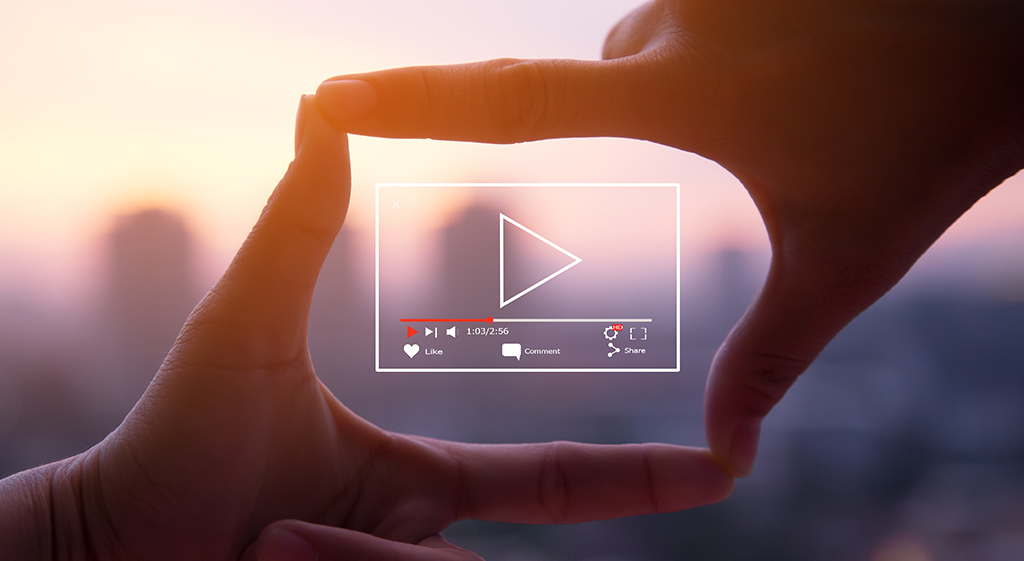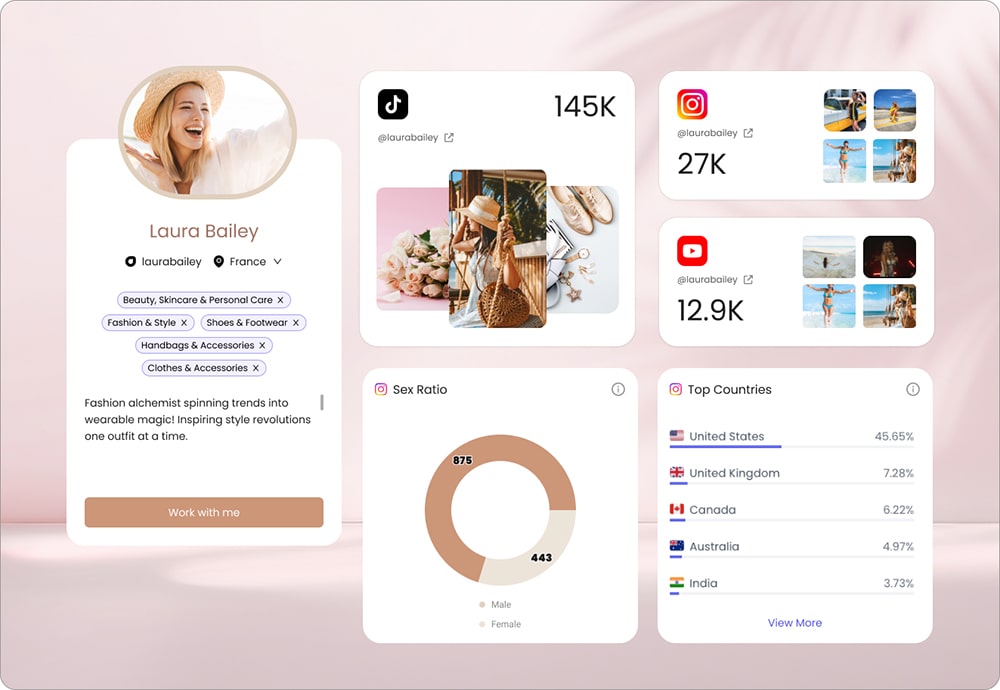Social media is not about creating pretty pictures and fun videos, especially if you do it professionally. It’s work, where time and resources are invested, and which is following certain goals.
To understand the effectiveness of your social media strategy and how well it works, there are a number of metrics that you need to take as benchmarks. These metrics can vary depending on your goal, the content type, and the specificity of your business, but they give you an important reference point for measuring the results of your work.
In this article, we go over a list of 13 social media metrics you may want to keep in mind and start tracking.
What Are Social Media Metrics?
Social media metrics are quantitative data points used to evaluate the performance and effectiveness of your or influencer marketing efforts across various social media platforms.
Depending on your goals, content, and overall brand objective, these metrics can vary significantly, ranging from reach to video views. For example, if your goal is to increase engagement by 30% over a period of 3 months, likes, comments, and shares become the metric that you need to measure to see if your campaign is successful. You then take a look at the number from your platform’s analytics over a period of time, comparing the numbers to the previous performance.
What Are Metrics And KPIs For Social Media?
Social media KPIs are the abbreviation of Key Performance Indicators, and their concept is much simpler than one imagines at first. Essentially, KPIs are the specific metrics that are important enough for you to measure. These are the metrics that are the most important for your business to measure and understand. They serve as quantifiable benchmarks that help marketers and creators track their progress toward achieving a certain goal in a clear and measurable way. The results of these measurements can then be used to optimize your social media efforts for better results.
Why Are Social Media Metrics So Important?
Social media metrics and KPIs are imperative to any social media strategy, and here’s why: without a clear benchmark, you simply cannot know if your performance and strategy have been effective. When you don’t have anything to compare them to, the views and impressions you get are numbers without any context.
Understanding which metrics to track and how to analyze them gives you valuable insights into how your content resonates with your audience, how your viewers perceive you, are your efforts so far in line with what you are looking to achieve, and the overall impact your posts have. They can also give you insights into what type of content your audience enjoys, which strategies are effective for different goals, and other important information you can use to draw your influencer marketing strategy, identify areas for improvement, and make data-driven decisions to achieve your social media goals. Knowing this key data and optimizing your content based on it can significantly improve your standing as a creator as the influencer marketing market sees a 14.47% year-over-year growth and the competition is likely to increase.
Key Social Media Metrics To Track As An Influencer
Now that you know what social media metrics and KPIs are, you may be asking which metrics you need to track as an influencer. The answer is, there is no right answer: there are too many metrics out there, all useful depending on the goals you are trying to tackle. Your metrics may even vary from collaboration to collaboration!
To help you understand which social media metrics exactly can be helpful to you in different cases, below, we go over a wide range of KPIs for different goals.
Brand Awareness Metrics

Brand awareness is not only for companies: you as an influencer have a brand, and there are several metrics that you can use to understand the extent to which your target audience is familiar with that brand.
Reach
Reach is the metric that quantifies how many times people were exposed to your content online. It’s the metric you need to track if you want to find out how many people know about you. Growing organic reach is a sure indicator that you are growing your presence online, appearing in front of the eyes of more and more people.
Impressions
Impressions are another brand awareness metric, and very often they are confused with reach. However, there is a big difference: impressions indicate how many times your content was displayed in contrast to reach, which shows how many people have actually seen your content. You can think of impressions as a metric that indicates the potential of your content, and how much more visibility it can achieve. It can also indicate how much your content resonates with your audience across platforms. Keep in mind that the number of your impressions will always be higher than that of reach. Check out some differences between reach and impressions here.
Social Media Mentions
The last brand awareness metric we want to discuss is social media mentions. More specifically, the number of times people mention or tag you on social media. These mentions can occur in various forms, such as direct @mentions, tags, or even indirect references through hashtags or discussions. This metric shows whether there’s any buzz around your name across social media platforms, and what are the sentiments around those discussions.
Social Media Engagement Metrics

Engagement is an umbrella term used to categorize the metrics used to understand how actively involved the audience is with your content and how effective your campaigns are. It essentially boils down to how much and how often your audience interacts with your content. A high engagement rate indicates the “health” of your audience: how interested your audience is in your content, as well as the ratio of real vs. fake followers. Engagement rates also indicate how interesting your content is for your audience. Below are some of the key social media metrics to track for engagement.
Likes
Having a large following isn’t helpful when your audience isn’t regularly interacting with your content, and the starting point of that interaction is the Like button. Likes are known also as “Applause rate”, which stands for the virtual applause, approval, thumbs-up you receive from your audience. Likes show that your audience watched your content and enjoyed it enough to react to it.
Shares
Another significant social media metric is shared, a KPI that reflects that users found it valuable or interesting enough to pass it along. It serves as a sign for the algorithm, indicating that the content is trusted, valuable, useful, or engaging, which can then improve the ranking of your content.
The importance of shares lies in their ability to amplify the reach and visibility of your message or piece of content: as content is shared by users, it reaches a broader audience beyond your immediate following. This organic sharing can result in increased exposure, potential new followers, and enhanced awareness.
Shares can also serve as social proof. When users see content being shared by their peers, it adds credibility and increases the likelihood of engagement.
By tracking and analyzing the number of shares, you can evaluate the effectiveness of their content strategy. It helps identify which types of content or campaigns are resonating with your audience and encourages them to share, and you can then use this valuable information to inform your future campaigns and content.
Clicks (CTR)
If you are using paid ads to promote your content on Instagram or other social media platforms, another fundamental engagement metric you need to track is the Click-through-rate (CTR). As the name suggests, this is the metric that measures the number of times users click on the link or call-to-action within a social media post or ad.
As an engagement metric, CTR is a direct indicator of user intent and action. When users click on a link, it demonstrates the viewer’s willingness to explore further who you are and what you are offering. By monitoring your CTR, you can assess the effectiveness of their content, campaigns, or calls-to-action.
Amplification rate
Amplification rate is a metric directly connected to the shares as it stands to indicate the average number of shares per post. An easy way to calculate the amplification rate (it is often expressed as a percentage) is by dividing the number of shares or retweets by the number of impressions or reach of the content and then multiplying it by 100. A higher amplification rate suggests that your content is compelling, valuable, or share-worthy, leading to increased brand exposure, wider reach, and potentially attracting new followers. It’s also a useful metric that you can use to compare your posts with each other, to see which performed better.
Virality rate
Virality rate is a social media metric that measures the rate at which a piece of content spreads across the social platform. A good way to calculate the virality rate is by dividing the number of shares by the number of unique views or impressions and then multiplying it by 100. The final number indicates the percentage of people who have seen your content and then went to share it with others. Naturally, the higher the virality rate, the more your content has resonated with your target audience, prompting them to share it with their network. Tracking the virality rate, similar to shares, allows you to track the success of your content in generating organic word-of-mouth marketing, and helps to identify the content that has the potential to go viral.
These were some of the most critical engagement metrics to track on social media. While some of them are seemingly independent from one another (likes, comments, and shares), to get the best idea on the performance of your content, you need to look at these metrics in conjunction with each other, and evaluate the results within the context of your overall strategy and goals.
Video Metrics

In addition to the metrics described above, there are two more social media metrics you need to know about, which are referring to video content specifically. These are video views and video completion rates.
Video views
In its simplest form, video view as a social media metrics to track is the total number of people who have watched your videos. A slight complication comes due to the ways different social media platforms count video views. On YouTube, for example, a view is counted when you intentionally watch more than 30 seconds of a video. On Instagram and Facebook, it’s 3 seconds, while on Twitter, the view is counted after 2 seconds. On TikTok, the social video giant, a view is counted as soon as the video starts playing.
Video views are sometimes considered vanity metrics, as without likes/comments/shares, they don’t add much to the bottom line. However, when studied in conjunction with other metrics, they can give critical insights into the performance and relevance of your video content.
Video completion rate
Another social media video metric, which comes hand-in-hand with video views, is the video completion rate. And as the name indicates, this is the metric that shows how many people watched your video until the end. This is a key indicator of how engaging, useful, and valuable your video is for your audience. And it’s an important indicator to social media algorithms that your video content is engaging, and it’s worth promoting a little more.
What are the top 3 metrics for social media ROI?

Lastly, there are several social media metrics that you need to keep your eye on if you are looking to understand your ROI, or that of the brand you collaborate with.
CTR
We mentioned CTR earlier in the article as the click-through-rate, the metric that essentially stands for how many people clicked on the link you’ve posted in your post, story, or bio. A good way to calculate your CTR is by dividing total clicks by the number of impressions. The final number can give you a good idea on how effective your campaign is.
Conversion rate
Conversion rate, or goal completion rate, indicates how many of the people who saw your content made a purchase, downloaded an app, or signed up to an event, depending on your goals. The conversion rate is calculated by dividing the number of conversions by the number of clicks. This number then helps you understand the effectiveness of your content in driving actual results and the level of engagement it generates. By tracking and optimizing your conversion rate, you can demonstrate the impact of your influence and provide valuable insights to brands about the return on investment they can expect from collaborating with you.
Cost-Per-Click (CPC)
Cost-per-click is a relevant metric specifically if you are running paid ads, and it helps you see how much does it cost you to run the campaign. It is also a metric that can be useful as part of your collaborations, as it can help you provide valuable information to the brands you work with on what exactly they receive for working with.
CPC is measured by dividing your ad spend by the total number of measured clicks and multiplying by 1000, and most social media analytics tools report on your CPC.
How Do You Measure Success On Social Media?
Now that you know what some of the most critical KPIs and social media metrics to track are, you need to know how to track them.
Luckily, it’s quite simple, and the abundance of KPI choices doesn’t make it any harder, and here’s why: all social media platforms come with built-in analytics tools that keep track of your content’s performance and analyze them. In addition to these native apps, there are many third-party social media analytics platforms that offer even more comprehensive analytics tools, targeted specifically to your needs.
The first step is understanding which are the metrics that you do want to track. For this, monitor such information as the overall reach of your content and the engagement with it, and narrow down the metrics you think are giving you more insights into what seems to work for your audience. Once you’ve chosen these metrics, you can start keeping track of the performance over periods of time, take note of the changes, both positive and negative, iterate your content accordingly, then measure again, to understand whether you are on the right track.
Conclusion
This is far from being an exhaustive list of metrics you can analyze. As you are choosing which metrics to track, keep in mind that strategy and preparation are key for effective performance measurement. Select only the metrics that align with your social media strategy, and observe how they change. By doing so, you will be able to eventually tell how effective your social media activity is, is there a place for growth, and how you can improve your results. Good luck!
Reviewed By Rem Darbinyan
Revolutionizing industries with AI, Rem Darbinyan is the CEO of ViralMango and an entrepreneur, AI expert, and influencer marketing strategist.




